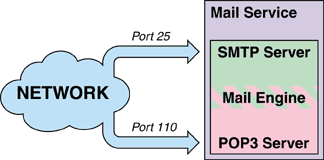It's somehow difficult to give a proper definition of "server",
due to the confusion created in the time so far by the different meanings
that term had, facing the different evolution of the technologies.
The term "server" is commonly used with at least three different
meanings:
-
"Server" as computer: With this meaning the
server term is intended to be the computer sharing resources.
Ex. Our corporate "server" is a double Pentium II
running at 450 MHz with 12 GB of SCSI hard disk running Linux.
-
"Server" as a program: With this meaning the
server term is intended to be the application that enables the
resource sharing, not caring about the network protocols it
implements.
Ex. Our Mail server is FlosieTek FTGate release 2.1 which
implements the SMTP and POP3 protocols.
-
"Server" as a protocol handler: With this meaning
the server term is intended to be the application that enables
the access to shared resources via a specified protocol.
Ex. Our HTTP server is Apache 1.3.4.
While we can clearly see the difference between the first definition of
"server" (computer) and the other two (applications), it's hard
to see the difference between the second definition ("server" as
a multi-protocol handler) and the third ("server" as a single
protocol handler).
Since it's crucial for all developers involved in the Avalon project to
share the same common idea of "server", I would like to define
a server as a protocol handler. We would, then, have HTTP servers,
SMTP servers or POP3 servers, but we cannot use the term MAIL server.
What we called the mail server is in fact the union of two (or more)
different "server"s (in our example the union of a SMTP and a
POP3 server).
We can clearly see, anyway, that a POP3 and an SMTP server will have to
share most resources and code to build up a complete mailing system, like,
for example, a central repository where messages could be stored. We would
then define the union of the SMTP server, the POP3 server and the central
messages repository (we could call it Mail Engine) as a Mail
"service". To clarify things a little bit, maybe a picture would
help:
| Server 1 |
 |
|
|



